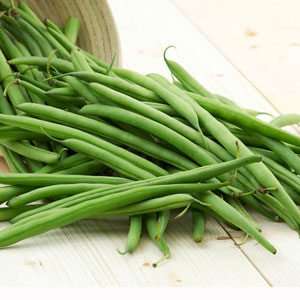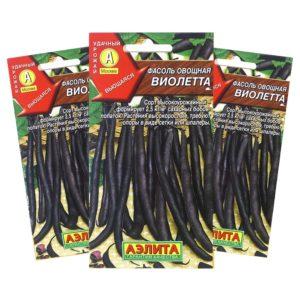How to grow delicious green beans in the country
String beans are one of the most widespread legumes in Russia. Its origin is Central America. Now green beans are cultivated all over the world. Growing and caring for beans is very simple.
In this article, we will take a closer look at how to grow green beans in the country using step-by-step instructions.
The content of the article
Characteristics and yield
Leguminous beans – a product that is widely used in cooking as a vegetable ingredient in salads, side dishes, first and second courses.
Black Eyed Peas - a variety of pods. They are long green beans, have softer shells and taste like asparagus.
Green beans are incredibly rich in nutrients and health benefits. This makes beans such a popular product around the world. It contains vitamins such as: A, C, B1, B2, E.
In addition, green beans contain macro- and microelements:
- calcium; maintains the health and density of bones, joints, nails, hair;
- potassium; promotes the normalization of the heart rate, and is also recommended for atherosclerosis;
- phosphorus and zinc; necessary for the body to metabolize fats and normalize hormonal levels;
- lecithin, which helps cleanse the walls of blood vessels;
- iron; has a beneficial effect on the supply of nutrients to the brain;
- folic acid; contained in pods and supports reproductive function in women, and during pregnancy it promotes fetal development. Plus, folic acid can help fight depression.
And even in addition to all of the above nutrients, green beans contain a large amount of simple protein and fiber, which improve digestion and cleanse the intestines.
The harvest time for green beans starts from the moment the fruits first appear. Green pods can be harvested several times per season. As a rule, the frequency of collection is 1-2 times a week. The number of pods harvested depends on many factors: bean variety, weather conditions, fertilizer and soil.

But in any case, by planting several germinated seeds of green beans of any kind, with proper care, even a novice gardener will reap a good harvest, which will be enough not only for the summer, but also for winter harvesting.
There are many varieties of green beans that vary in size, shape, color, and flavor. On average, the length of the pod ranges from 7 to 15 cm, up to 9 beans ripen in each pod.
In the photo of green beans, you can see what the beans look like in the pods and what different colors can be found depending on the variety. The seeds, respectively, of beans can also have a variety of colors.
The best varieties of green beans
Consider the most popular types of green beans.
Purple queen
A bushy variety of green beans that combines fruit and ornamental functions. Produces dark purple pods that grow up to 16 cm in length. This bean variety is resistant to many diseases and pests, as well as to adverse weather conditions. Gives a large harvest.
Crane
The variety is small in size, not exceeding 60 cm in height. It is unpretentious and brings a good harvest. Suitable for preparing a wide variety of dishes, as well as for freezing and preserving.
Sachs 615
A bushy early-ripening variety of beans that produces large green pods (about 13 cm long).Differs in saturation with a variety of vitamins and nutrients.
Oil king
An unusual variety of beans that bears fruit in yellow pods with a very specific taste. The growth and development of this variety of beans occurs within two months.
How to grow green beans
How to grow green beans in the garden? This question is asked by all novice summer residents. In fact, the algorithm for planting and caring for a plant is extremely simple and does not require much effort. Growing beans begins with preparing the soil for planting a plant.
How to prepare a garden bed
First of all, you need to choose the right place for the location of the garden. The plant requires a well-lit area, but not subject to drafts. The chosen place is thoroughly dug up. It is advisable to do this already in the fall.
In addition to the usual digging into the soil, it is worth adding a number of fertilizers:
- Humus (5 kg per 1 sq. M).
- Superphosphate (30-40 g per 1 sq. M).
- Potassium chloride (about 20 g per 1 sq. M).
In the spring, you can also add a little complex fertilizers (with potassium content): 30 g per 1 sq. m. After that, you need to loosen the soil, which will contribute to a good planting, and subsequently help the roots of plants to receive nitrogen.
Important! Do not plant green beans in too stony or clayey soil! This can interfere with seed germination.
Sowing seeds
After preparing the soil, we are preparing the seeds for planting. Planting green beans is similar to planting any other legume.
The algorithm for soaking seeds for their favorable germination will help you:
- The seeds are poured into a tissue bag and immersed in a warm (about + 40 ° C) solution of water and potassium permanganate for a short period of time.
- Then the seeds are washed with water and wrapped in any damp cloth for 5-6 days. Be sure to make sure that the fabric does not lose moisture, moisten it as needed.
- Maintain a temperature of + 25-30 ° C to create a favorable climate for the seeds.
Approximately in May (or that week of the season in which the earth warms up to + 15-17 ° C), the sprouting seeds are planted in the soil.
Important! At first, the seeds are sensitive to temperature changes. It is worth excluding the onset of frost or protecting the planting site with a greenhouse or greenhouse.
A few minutes before laying the beans, it is necessary to soak for about 4 minutes in an aqueous solution of boric acid (0.2 g / l) for increased immunity to diseases.
It is better to plant the seeds at a distance of at least 10 cm from each other (if it is a variety of climbing beans) or at a distance of 20 cm (if it is a bush bean). This method of planting will simplify the growth and development of plants, as well as make it convenient to care for the garden and harvest.
For any variety, germinated seeds are laid to a depth of about 3 cm, 2-3 pieces in each hole. After that, sprinkle the bed with humus. According to statistics, the first shoots appear 10 days after planting.
Read also:
How does beans affect the male, female and children's body?
Care and feeding
Green beans, like asparagus, require regular watering. However regularly doesn't mean a lot... Green beans do not like too much moisture; there should be no standing water in the garden bed. If you follow the watering rate (2-3 times a week, depending on the climate), you will get fleshy juicy pods and a good harvest.
Watering is increased during the flowering period (a month after the emergence of sprouts). To increase the yield, add a variety of fertilizers to the water (even the simplest nutritious infusion is suitable: soak the weeds in a barrel of water for 7 days and add the resulting fertilizer to a bucket of water, 1 liter each for watering the garden).
The main rule is to avoid dry crust on the ground. This will damage the growth and development of the plant (for example, freshly sprouted seedlings may break on hard, dry soil).
Important procedures are soil loosening and weeding. This should be done regularly: loosen after each watering, weed as weeds grow. Loosening will allow the roots to be oxygenated, while weeding will keep the nutrients inside the plant.
Since beans are usually a tall plant (depending on the variety), they require tying for normal development. If you are making a vertical garter, you need to install a support for the bush (it can be a peg, a stick) and tie a branch and / or a stem to it with a piece of rope. This will make it easier for the plant to grow and develop.
A horizontal tie (if growing in a greenhouse) uses a high-tension wire or rope from one end of the greenhouse to the other. Ropes will be attached to it to support the branches and stems of plants.
Among other things, it is useful to periodically fertilize the soil with mineral or organic fertilizers. If these are dry fertilizers, then they are placed at the very surface of the soil, slightly loosening the top layer. If fertilizers are diluted in water, watering is done at the very soil with a watering can with a narrow neck.
Important! Make sure that fertilizers do not get on the leaves of the plants, this can burn them.
Prevention of diseases and pests
Watch out for pests or plant pathogens to avoid losing your crop.
The most common diseases of beans:
- Powdery mildew... A fungal disease that affects the leaves of a plant with a white bloom. Diseased leaves may fall off over time, but do not wait. Tear them off as soon as you see the onset of the disease to avoid transfer of the fungus to healthy leaves. Spray the bushes with a 1: 9 solution of milk powder and water twice a week. You can also add 1 part vinegar or baking soda to improve the effect.

- Anthracnose... The disease leads to fruit rotting and manifests itself as a brown rash on the leaves of the plant. As a treatment, spraying with Bordeaux liquid is suitable. Treatment with copper chloride is also recommended.
- White rot... The disease leads to softening of stems and leaves or the appearance of white spots on them. For treatment, it is necessary to remove the diseased parts of the plant or sprinkle them with charcoal or chalk.
- Root rot... With such a disease, the main root of the plant suffers, as a result of which the plant withers. Plaque may form on infected areas. To fight the disease, soil disinfection is needed.
- Mosaic... The color of the leaves gradually becomes bright, multi-colored, like a mosaic. Leaf tissue may wrinkle, swelling in some places. Plant growth and development is severely impaired. Use aphid repellent as a preventive measure.
There is also the possibility of damage to green beans by some pests, including:
- Slugsthat live on weeds. They can simply move from them to the bed of beans, so it is necessary to weed on time.
- Whitefly... Absorbs all the juice from the leaves. As a preventive measure, it is recommended to rinse the leaves.
- Sprout fly... It gnaws at the base of young shoots and can completely destroy the crop. Sprout flies are initially found in the ground in the form of larvae, which must be mechanically removed.
- Melon aphid... Transfers various diseases. Pollination with ground sulfur or soapy water is recommended (add 1/4 piece of grated laundry soap to 1 liter of water, you can add 1 tablespoon of baking soda).
Conclusion
Preparing green beans seeds, planting them and caring for plants is easy even for novice gardeners. Green beans are useful and grow in almost all regions of Russia. Using the materials of the article, you can easily get a good harvest of beans and use it in a variety of dishes and preparations for the winter.